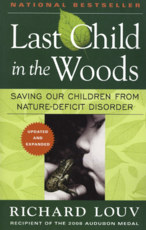 Excerpt
from Last Child in the Woods: Saving Our Children from Nature-Deficit Disorder
Excerpt
from Last Child in the Woods: Saving Our Children from Nature-Deficit Disorder
by Richard Louv
Kids Outside
In the United States, children are spending less time playing outdoors
-- or in any unstructured way. From 1997 to 2003, there was a decline
of 50 percent in the proportion of children nine to twelve who spent
time in such outside activities as hiking, walking, fishing, beach
play, and gardening, according to a study by Sandra Hofferth at the
University of Maryland. Also, Hofferth reports that children's free
play and discretionary time in a typical week declined a total of nine
hours over a twenty-five-year period. Also, children spend less time
playing outdoors than their mothers did when they were young, according
to Rhonda L. Clements, a professor of education at Manhattanville
College in New York State. She and her colleagues surveyed eight
hundred mothers, whose responses were compared to the views of mothers
interviewed a generation ago: 71 percent of today's mothers said they
recalled playing outdoors every day as children, but only 26 percent of
them said their kids play outdoors daily. "Surprisingly, the responses
did not vary a great deal between mothers living in rural and urban
areas," Clements reported. "However, this finding coincides with
research conducted in England and Wales." The results of those studies
negated the assumption that children living in rural areas would have
access to greater public space for play and recreation. They found that
farmlands, with their restricted use and lack of local supervision for
children's activities, did not offer the rural child more opportunities
for outdoor experiences.
Some researchers have suggested that the nature deficit is growing
fastest in English-speaking countries. That may be true, but the
phenomenon is occurring in developing countries in general. The Daily Monitor,
published in Addis Ababa, Ethiopia, issued a plea in March 2007 for
parents to get their children out of the house and into the outdoors,
noting that "many Ethiopians will have reached adulthood far removed
from outdoor experiences."
One U.S. researcher suggests that a generation of children is not only
being raised indoors, but is being confined to even smaller spaces.
Jane Clark, a University of Maryland professor of kinesiology (the
study of human movement), calls them "containerized kids" -- they spend
more and more time in car seats, high chairs, and even baby seats for
watching TV. When small children do go outside, they're often placed in
containers -- strollers -- and pushed by walking or jogging parents.
Most kid-containerizing is done for safety concerns, but the long-term
health of these children is compromised. In the medical journal the Lancet,
researchers from the University of Glasgow in Scotland reported a study
of toddler activity where the researchers clipped small electronic
accelerometers to the waistbands of seventy-eight three-year-olds for a
week. They found that the toddlers were physically active for only
twenty minutes a day. Similar patterns were found among Ireland's rural
children. Clearly the childhood break from nature is part of a larger
dislocation -- physical restriction of childhood in a rapidly
urbanizing world, with nature experience a major casualty.
As the nature deficit grows, another emerging body of scientific
evidence indicates that direct exposure to nature is essential for
physical and emotional health. For example, new studies suggest that
exposure to nature may reduce the symptoms of Attention Deficit
Hyperactivity Disorder (ADHD), and that it can improve all children's
cognitive abilities and resistance to negative stresses and depression.
Nature-Deficit Disorder
The overarching importance of this research combined with our knowledge
of other changes in the culture demands a shorthand description. So,
for now, let's call the phenomenon nature-deficit disorder. Our culture
is so top-heavy with jargon, so dependent on the illness model, that I
hesitate to introduce this term. Perhaps a more appropriate definition
will emerge as the scientific research continues. And, as mentioned
earlier, I am not suggesting that this term represents an existing
medical diagnosis. But when I talk about nature-deficit disorder with
groups of parents and educators, the meaning of the phrase is clear.
Nature-deficit disorder describes the human costs of alienation from
nature, among them: diminished use of the senses, attention
difficulties, and higher rates of physical and emotional illnesses. The
disorder can be detected in individuals, families, and communities.
Nature deficit can even change human behavior in cities, which could
ultimately affect their design, since long-standing studies show a
relationship between the absence, or inaccessibility, of parks and open
space with high crime rates, depression, and other urban maladies.
Copyright © 2008 Richard Louv
